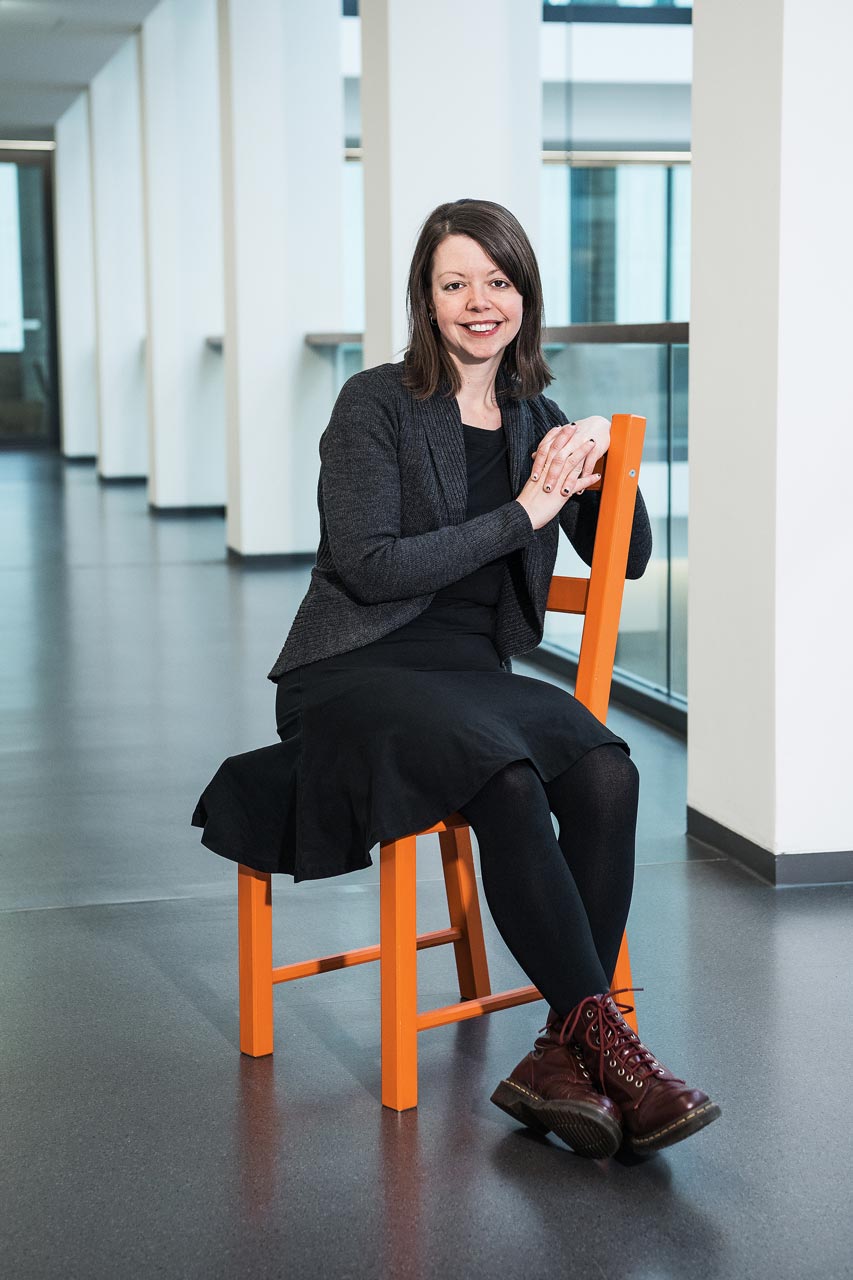On the quest for the Holy Grail of medication development
A woman of action: Dr. Martha Sommer, an American biochemist, has found her niche as a researcher in the protein arrestin and recently simply went ahead and started up her own research team as a BIH Delbrück Fellow at the Charité. The mother of two treasures her independence in the laboratory and considers that society has a duty to offer women who wish to have children opportunities in science as well.
Dr. Sommer, if you could impart just one message to the world outside the laboratory in this interview, what would it be?
Encouraging women to pursue careers in science is a subject very close to my heart.Women are awardedover half of all university degrees, then 30 or 40 per cent of postdocs are women and finally you find hardly any women at the group leadership level – I’m the only one in my department. The main reason is still that many women don’t manage to pursue their careers alongside their family responsibilities. Many are aware of the problem and there are also men who face the same situation, but few speak about it publicly. It is the task of society as a whole to combat this inequality. However, the fact that society is in a constant state of flux gives me hope. If my grandmother had wanted to pursue a career, there were only three options open to her back then: teacher, secretary or nurse. But scientist? That would never even have entered her head. So, there’s already been quite a lot of progress in just three generations. Now it’s up to us to continue this process of change.
What fascinates you about science?
I love all sciences, but biology fascinates me the most. Founded on the basic principles of science, it creates cells, life and organisms. Actually, everything in this world tends towards chaos and it requires a great deal of energy to hold it all together. So ultimately, life is a battle against entropy: a continuous striving and expenditure of energy to keep us in an organized state. We have a body, consciousness, aims and feelings – only due to these cells. In the end, everything is based on the laws of physics and chemistry.
What are you yourself working on in your research team?
In my research team, we’re studying what are called G protein-coupled receptors (GPCR). Over 800 different types of this receptor are found in the human body and are involved in almost every physiological process – sight, hearing, taste and in regulating the heartbeat. My specialty is the protein arrestin, which binds to this receptor. Its classic function is to block the G protein by binding the receptor. However, it can also cause the receptor to be transported into the cell in a vesicle. In addition, arrestin itself also works as a signal protein, in that it brings other proteins together. So, arrestin has a complex biological function and I research its interaction with the receptor.
Why does our body need arrestin?

Funding program
BIH Delbrück Fellows
Funding period
2016 – 2021
Project title
Structural and functional analysis of arrestin-GPCR complexes
Research area
Biophysics
Institution
Charité – Universitätsmedizin Berlin
Since 2013
Principal investigator of the working group “Arrestin“, Institute of Medical Physics and Biophysics, Charité – Universitätsmedizin Berlin
2007 – 2013
Post-Doc, International Research Fellowship of the National Science Foundation (USA), Institute of Medical Physics and Biophysics, Charité – Universitätsmedizin Berlin
2000 – 2006
PhD, Department of Biochemistry and Molecular Biology, Oregon Health and Science University, USA
Arrestin is present in every cell of the body, otherwise life would not be possible. However, we know very little about its function, as it is so diverse. The structure of the protein must be extremely complex in order to be able to fulfil so many different functions. We want to find out how this is even possible from a molecular point of view. To do this, we study the visual system and use the rod cells of the eye that are responsible for night and twilight vision as a model system. The GPCR of the visual system can be activated by light, which is useful for experiments. I mark certain parts of the arrestin with a fluorescent colorant, which enables me to observe the interactions and movement of the arrestin.
Do you believe that your research results can be transferred to other fields as well?
GPCRs are relevant to many research disciplines, as they are one of the main targets of medications. 30 to 50 per cent of all pharmaceuticals work through the GPCRs – for example, beta blockers and antipsychotic medications. These medications can create dependency and side effects that are probably connected to the function of the arrestin. When the active substances attach to the receptor, arrestin binds them in such a way as to cause undesirable effects in the cell. So ideally, we need to develop active substances that bind the receptor without simultaneously stimulating the arrestin: this is the Holy Grail of medication development. But as long as we don’t know how arrestin functions at the molecular level, it’s unlikely that it will be possible to develop such substances.
As a researcher, do you have any concrete goals that you want to achieve in the next few years?
Actually, I don‘t set myself any goals, but take opportunities as they come. Working in the lab is like playtime for me, which is why I want to continue to carry out research myself. However, I also enjoy writing.
The fact that you founded your own research team shows that you not only take opportunities that come to you, but also actively create them. Perhaps you are getting closer to the Holy grail of medication development with your current project and are thus laying the foundations for further research projects?
Being funded as a BIH Delbrück Fellow gave me the opportunity to explore options, to go to conferences and to talk to interesting research groups. It makes me independent and has made it possible for me to have an independently financed post. The five-year funding period is not only generous, but also more realistic for developing innovative research projects. Most fellowships run for two or three years. That’s not long enough for an innovative research project – you need a minimum of five years to venture somewhat more risky projects. That gives you enough time to further develop experiments that don’t work at first. I don’t yet know what I’ll be doing next. But there’s still a lot to discover about arrestin and there are still many questions that I’m very keen to find answers to.
December 2017 / MM
